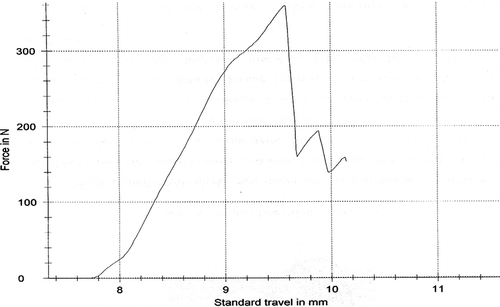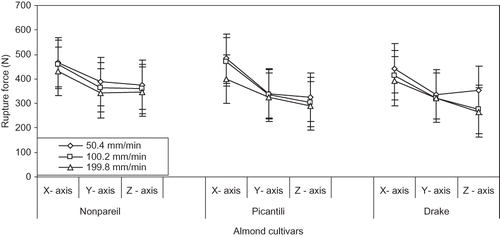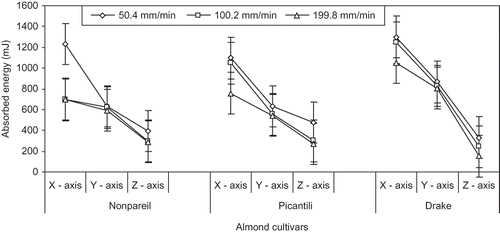Abstract
The effects of compression in different axes and speeds on mechanical properties and selected geometric properties of almond cultivars were investigated. The average sphericity, volume and surface area ranged from 60.5 to 71.1%; 3.52 to 3.81 cm3 and 0.60 to 0.61 cm2 for almond cultivars. The greatest and least rupture force of almond were obtained along the X and Z axes for each cultivar. The results indicated that the effects of compression along the axis and speed on the rupture force were highly dependent on almond cultivars. Selected mechanical properties were affected by geometric and mechanical parameters of almond cultivars.
INTRODUCTION
Almond is widely growing in Anatolia and Turkey with an annual production of about 45.000 tons.[Citation1] Almond harvesting and cracking are still done manually, which increases processing time and cost for kernel extraction in Turkey. In order to design equipment used in harvesting, transporting, storing, cracking, handling, and processing of nuts and kernels of almonds; the geometric and mechanical properties of local almonds should be determined. In the design of almond cracking and grinding machine, mechanical properties of nut and kernels are important to know.
In postharvest, the most important operation is nut cracking to extract kernel from the almond nut. Shell hardness of almond nut changes in relation to almond cultivars and the cracking operation is affected by geometric and mechanical properties of almond cultivar. Compression orientation and speed affect the amount of force applied to crack almonds. Thus, postharvest processes such as cracking and grinding systems must be designed based on the geometric and mechanical properties. Harvesting and handling of the almond are carried out manually. The threshing is usually carried out on a hard floor with a homemade threshing machine. For optimum threshing performance, processes of pneumatic conveying, storing and other processes of almond nut, its geometric properties and mechanical properties must be known.[Citation2]
The mechanical properties of agricultural materials are necessary in designing and effective utilization of the equipment used in the transportation, processing, packaging and storage of agricultural products. Several researchers have investigated the physical and mechanical properties of various crops such as macadamia nut[Citation3] ; castor nut[Citation4] ; raw cashew nut[Citation5] ; hazelnuts[Citation6,Citation7] ; arecanut kernel[Citation8] ; groundnut kernel[Citation9] ; almond nut and kernel[Citation2] ; shea nut[Citation10] ; pine nuts[Citation11] ; mangoes[Citation12] ; peach[Citation13] ; peanut[Citation14] and walnut.[Citation15,Citation16]
Dursun[Citation17] reported the compression position influenced the amount of force applied to crack of walnuts and other nuts. Additionally, the above author reported that the cracking position had an important on various nuts. Oloso and Clarke[Citation18] evaluated the effect of moisture content, pre-damage cultivar, and direction of loading on rupture force, rupture energy and rupture deformation under compression tests for roasted cashew nuts. Liu et al.[Citation19] reported the cracking behaviour of macadamia nut's shell by theoretically and numerically. Gurhan et al.[Citation20] evaluated the mechanical behaviour of three apricot cultivars under compression loading at three axes and different deformation speeds. Guner et al.[Citation7] evaluated the mechanical behaviour of hazelnut cultivars under compression loading and two deformation rates to determine the rupture force, specific deformation and rupture energy required to initiate nut and kernel rupture.
Limited researchs have been conducted on the mechanical properties of almond. Some engineering properties of almond, such as rupture strength, sphericity were reported by Kalyoncu[Citation21] ; Aydin.[Citation2] However, there is insufficiency of technical information and data of different cultivars of almond in the scientific literature with regards to the mechanical behaviour of almond nut under different compression axis and compression speed. The objective of this study was to investigate the effect of compression speed and axis on mechanical behaviour and selected geometric properties such as size dimension, sphericity, unit mass and surface area of almond cultivars (Nonpareil, Picantili, and Drake). The mechanical properties examined were rupture force, specific deformation, absorbed energy and required power to rupture.
MATERIALS AND METHODS
The almonds were obtained from the production of 2007 and almond orchard of Gaziosmanpasa University in Tokat, Turkey. The almond orchard was arid and non irrigated. Almond trees' ages are for five years. The almond cultivars used in the study are the international cultivars. Nonpareil and Drake cultivars are originated from USA and Picantili cultivar is from Russian.[Citation23] The almond samples were cleaned to remove impurities, damaged, and broken nuts. The dimensions, sphericity, unit mass, volume, surface area of almond nut and kernel were determined. The moisture content of the almond nut and kernel samples were determined using the method recommended by Braga et al.[Citation3] The tests were carried out on almonds at moisture contents of nut and kernel 9.74 and 3.87% (Nonpareil); 9.54 and 5.31% (Picantili); 9.79 and 4.71% d.b (dry basis; Drake), respectively.
To determine the average size of the almond, a sample of 100 almonds was selected randomly. The length, width, and thickness of almonds were measured. Along the three major perpendicular axes, the dimensions of the almond were measured by a dial-micrometer to an accuracy of 0.01 mm. To obtain the unit mass, each nut and kernel were weighted with an electronic balance to an accuracy of 0.001 g. The geometric mean diameter (Dg), sphericity (Φ) and volume (V) of almond were calculated by the following relationships.[Citation2,Citation24]
where, L is the major axis dimension, W is the minor axis dimension and, T is the thickness in mm. The surface area of almond nut was found by analogy with a sphere of same geometric mean diameter, using expression cited by Olajide and Ade-Omowaye:[Citation24]
Figure 2 Representation of the three axial forces (Fx , Fy , and Fz axial forces) and three perpendicular dimensions of almond nut.
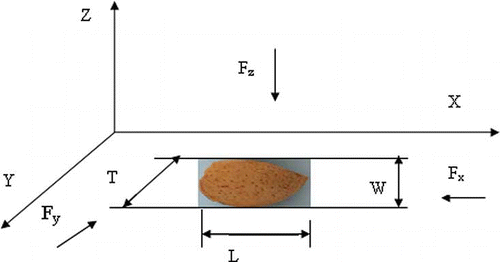
RESULTS AND DISCUSSION
Geometric Characteristics
The average nut and kernel size dimensions of the three almond cultivars were presented in . The mean values of unit masses of nut and kernel for Nonpareil, Picantili and Drake almond cultivars were 2.30, 0.89 g; 2.77, 1.07 g, and 2.00, 0.81 g, respectively. The greatest values of unit mass of almond nuts were obtained for Picantili followed by Nonpareil and Drake cultivars, respectively. Arslan and Vursavuş[Citation28] reported that Ferragnes, Ferradual, and Guara nut masses (3.67, 3.95, and 4.01 g) were slightly higher than those of reported in this study.
Table 1 Some geometric properties of almond cultivars.Footnote*
The average length (27.11, 31.26, and 27.09 mm), width (18.90, 19.26, and 18.53 mm), thickness (14.13, 11.51, and 13.83 mm), and geometric mean diameter (19.28, 18.95, and 18.76 mm) of the Nonpareil, Picantili and Drake nuts were recorded in this experiment, respectively. The greatest values of dimension of almond nut and kernels were obtained for Picantili followed by Nonpareil and Drake cultivars, respectively.
The mean values of sphericity for almond cultivars were 71.1% for Nonpareil, 60.5% for Picantili, and 69.4% for Drake cultivar respectively. The highest value of sphericity for almond nut was obtained from Nonpareil cultivar. The mean values of surface area of nut of Nonpareil, Picantili and Drake cultivars were 0.61 cm2, 0.60 cm2, and 0.60 cm2, respectively. The obtained values of surface area were similar for each cultivar. The mean shell thickness of almonds were 1.94, 2.43 and 1.89 mm for Nonpareil, Picantili and Drake cultivars, respectively (). Aydin[Citation2] reported shell thickness of almond (2.61 mm) are slightly higher than those of reported in this study.
Mechanical Properties
Rupture Force
The force required to initiate nut rupture in samples with varying almond cultivars along the three different compression axes is presented in . The lower force required to initiate nut rupture along the Z axis were obtained for Nonpareil, Picantili and Drake cultivars. The rupture force of almond nut decreased from 467.9 to 341.8 N, 483.0 to 289.7 N, and 443.6 to 264.12 N as the compression speed increased from 50.4 to 199.8 mm/min for Nonpareil, Picantili, and Drake, respectively. The results indicated that the rupture force along all three axes is highly dependent on cultivar over the compression speed ranges that were investigated. Greater force was required to rupture of nuts with Nonpareil cultivar being tested at the lower compression speed. The rupture force of almond decreased as the compression speed increased from 50.4 to 199.8 mm/min for all three almond cultivars. The greatest force was required to rupture kernels with Picantili cultivar as 483.0 and 469.9 N when loading along X axis at 50.4 and 100.2 mm/min compression speeds, respectively. These results might have concluded from the higher values of shell thickness of Picantili than the other cultivars. Rupture force of Picantili cultivar increased as its shell, dimension, and compression speed increases.
Borghei et al.[Citation29] reported the importance of walnut compression axis and dimension effect on the rupture force and deformation among walnut cultivars. They also reported the rupture force and deformation increased while walnut dimension increased. Khazaei et al.[Citation15] reported the compression speed, nut dimension and compression orientation had significant effects on cracking force and required power to fracture. Required force to rupture the almond increased as shell, dimension and compression speed increased. It is also reported by Khazaei et al.[Citation15] that the higher rupture force for big almonds may be due to their thicker shell.
The loading axis with the least resistance to rupture force of almond was the Z-axis. The rupture force of nut measured when loading along the suture thickness (Z-axis) was obtained from 376.2 to 347.8 N (Nonpareil), 325.3 to 289.7 N (Picantili), and 353.7 to 264.1 N (Drake) cultivar at the 50.4, 100.2, and 199.8 mm/min compression speeds, respectively. The higher rupture forces of almond required when loading along the X-axis were found for all three almond cultivars. The lowest rupture force for almond nut was obtained as 264.1 N for Drake cultivar loading along Z axis at 199.8 mm/min compression speed. Generally, the lower rupture force for almond nut was obtained at 199.8 mm/min compression speed for all three almond cultivars.
The effects of cultivar, compression speed and axis on rupture force were significant (P < 0.01). In this study, cracking of almond nut along X axis requires the greater force than along the Y and Z axes. Dursun[Citation17] reported the average rupture forces for required cracking of almonds at longitudinal axis through the hilum (X), right angles to the longitudinal axis (Y axis) and along the suture line (Z axis) were obtained as 209.1, 244.6 and 149.4 N, respectively.[Citation17] Khazaei[Citation15] reported the mean rupture force values of almonds changed 778 N, 626 N and 549 N along the 5, 100 and 200 mm/min loading rate, respectively.[Citation15] Aydin[Citation2] reported that the maximum rupture forces required to crack almonds were occurred along the longitudinal axis (X). Koyuncu et al.[Citation30] reported that the maximum and minimum forces required to crack walnuts (Yalova-3 cultivar) were occurred at right angles to the longitudinal axis and along the longitudinal axis. They determined the effects of compression orientation, geometric mean diameter and shell thickness of walnut on the rupture force. They found the rupture force loading along X axis required less force and yielded the best kernel extraction quality for walnut cultivars. Koyuncu et al.[Citation31] reported that the average rupture forces required to crack almonds at longitudinal axis through the hilum (X) obtained as 246.7 and 167.4 N for Bilecik and Sebin walnut cultivars, respectively. Kilickan and Guner[Citation32] ; Sharifian and Derafshi [Citation26] reported that, the rupture force increased as compression speed, shell thickness, fruit and pit size increased for olive and walnut.
Specific deformation
The mean values of specific deformation of almonds are presented in . The specific deformation decreased along the compression axis as the compression speed increased. The specific deformation values for almond cultivars ranged from 17.2 to 14.4% (Nonpareil), 18.5 to 13.8% (Picantili), and 20.1 to 20.0% (Drake) as the compression speed increased through the three test speeds, respectively. The results show that the specific deformation along any of the X-, Y- and Z- axes is highly dependent on the almond cultivar over the range of compression speeds investigated.
Figure 4 Effects of cultivar, compression axis and speed on specific deformation ϵ (%)of almond nut.
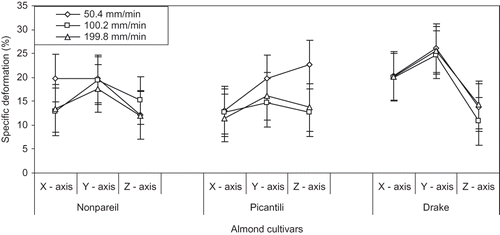
The specific deformation value was found that loading along Y axis for Drake cultivar was higher than the other cultivars. The lowest specific deformation value (10.81%) was obtained for Drake cultivar loaded along Z axis. The loading axis that yielded the least specific deformation was the Z-axis. The specific deformation measured while loading along the right angles to the longitudinal axis (Y-axis) ranged from 19.7 to 17.7% (Nonpareil); 19.7 to 16.1% (Picantili); and 26.12 to 25.6% (Drake) cultivar, respectively. The highest specific deformation values were observed for each almond cultivar when loading along the Y-axis. Statistical analysis showed that the specific deformation differences among the almond nuts were significant for cultivar, compression axis and compression speed were significant. Guner et al.[Citation7] reported that the maximum and minimum specific deformation of hazelnut cultivars were occurred at Z axis (8.65%) and X axis (5.48%). These results for hazelnuts are slightly higher than those of reported for almond in this study. Koyuncu et al.[Citation30] reported the specific deformation was inversely correlated with shell thickness for length and was found to be weak for width and suture position. They also reported the specific deformation was required to crack as geometric mean diameter increased. Braga et al.[3] reported similar results for macadamia nuts.
Absorbed energy
The absorbed energy of rupture decreased along the compression axis as the compression speed increased in the three almond cultivars (). The results indicate that the absorbed energy along any of the test axis is generally highly dependent on the compression speed and almond cultivar tested. The higher absorbed energy of almond was obtained for Nonpareil, Picantili and Drake cultivars along the X-axis (Fx ) than those loaded along the other axes. The effects of cultivar, compression speed, and axis on absorbed energy were significant (P < 0.01). The absorbed energy values of almond ranged from 1229.9 to 289.4 mJ (Nonpareil), 1096.4 to 270.7 mJ (Picantili) and 1298.9 to 153.2 mJ (Drake) when loading along the compression axis tested. The absorbed energy values for Nonpareil were lower than those Picantili and Drake cultivars. The results might have concluded from the higher values of geometric mean diameter of Nonpareil cultivar.
Similarly, Koyuncu et al.[Citation30] reported the rupture energy decreased with increase in geometric mean diameter and correlated negatively. They also reported the maximum and minimum energy required to crack walnuts (Yalova-3 cultivar) occurred at right angles to the longitudinal axis (0.440 J) and along the suture positions (0.273 J). Koyuncu et al.[Citation31] reported the average absorbed energy required to crack walnuts at longitudinal axis through the hilum (X) obtained as 0.46 and 0.07 J for Bilecik and Sebin walnut cultivars, respectively. Khazaei et al.[Citation15] reported the mean absorbed energy values of almonds ranged from 540 mJ, 482 mJ and 450 mJ along the 5, 100 and 200 mm/min loading rate, respectively. They also reported the absorbed energy increased with increasing almond dimension, shell thickness increased as the compression speed increased, but decreased with further increase in compression speed. Saiedirad et al.[Citation33] reported the rupture force and absorbed energy decreased as compression speed increased. They investigated the interaction effect of orientation, size, and moisture content on rupture energy. The lowest difference in absorbed energy among different levels of moisture content was related to large size.
Power of cracking
Power of cracking values determined along the X axis were higher than those observed for either the Y and Z axes (). And also the power of cracking observed when testing almond nuts along the X axis was greater than that of the other axes tested at the higher compression speeds. The effect of the cultivar, compression axis and speed on power of cracking was significant (P < 0.01). The loading axis with the lowest values for power of cracking was the Z-axis.
Figure 6 Effects of cultivar, compression axis and speed on required power for cracking P (W) of almond nut.
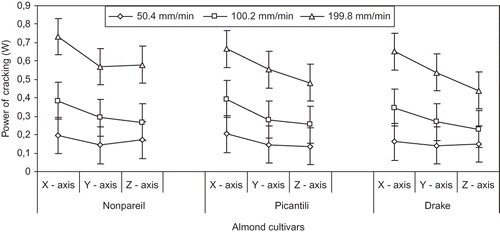
Power of cracking measured while loading along longitudinal axis (X-axis) ranged from 0.20–0.73 W (Nonpareil), 0.20–0.67 W (Picantili), and 0.18–0.65 W (Drake) cultivar, respectively. The lowest power of cracking values changed from 0.17–0.58 W (Nonpareil), 0.14–0.48 W (Picantili), and 0.15–0.44 W (Drake) when loading along the Z- axis for the three compression speed categories tested. The power of cracking values for almond cultivars tested in the X-axis were higher than almonds tested in the Y and Z axes. The mean power required of cracking values of almonds ranged from 0.04 W, 0.81 W, and 1.15 W along the 5, 100, and 200 mm/min loading rate, respectively.[Citation15] These results are slightly higher than those of reported for almond in this study. Khazaei et al.[Citation15] reported the required power for cracking increased with increasing almond dimension and the compression speed. The difference between power of cracking big and medium almonds was not statistically significant.
CONCLUSION
The geometric characteristics and mechanical properties of almond cultivars were determined. The greatest values of size dimension were obtained for Picantili cultivar, whereas, sphericity and surface area values were for Nonpareil cultivar. The mechanical behaviour of almond cultivars to crack was determined by measuring the average rupture force, specific deformation, absorbed energy and power of cracking along the X, Y, and Z axes at different compression speeds. The greatest amount of force required to crack the nut was required when nuts were loaded along the X-axis and the least compression force was required along the Z-axis for Nonpareil, Picantili, and Drake cultivars. The highest rupture force occurred for Nonpareil loaded on the X axis among the three almond cultivars, whereas the highest specific deformation and absorbed energy obtained for Drake cultivar. The results indicated that when testing the effect of compression axis on the rupture force is highly dependent on almond cultivars. The lowest force needed to rupture of almond was found with Drake at 199.8 mm/min compression speed among almond cultivars. The lowest force and absorbed energy for initiation of rupture were obtained in Drake cultivar as compared to other cultivars. Rupture force decreased with an increase in compression speed ranged from 50.4–199.8 mm/min. The power of cracking values for almond cultivars tested in the X-axis was higher than Y- and Z-axes. The lowest power required to rupture of almond was found in almond cultivars with Drake that were tested at 199.8 mm/min compression speed. The selected mechanical properties such as rupture force, specific deformation, absorbed energy and required power to crack for almond were affected by the geometric mean diameter, shell thickness and compression axis and speed.
REFERENCES
- FAO. Statistical Database. 2005 http://faostat.fao.org (Accessed: 11 December 2007 ).
- Aydin , C. 2003 . Physical Properties of Almond Nut and Kernel . J. Food Eng. , 60 : 315 – 320 .
- Braga , G.C. , Couto , S.M. , Hara , T. and Neto , J.T.P.A. 1999 . Mechanical Behaviour of Macadamia Nut under Compression Loading . J. Agric. Eng. Res. , 72 : 239 – 245 .
- Olaoye , J.O. 2000 . Some Physical Properties of Castor Nut Relevant to the Design of Processing Equipment . J. Agric. Eng. Res. , 77 : 113 – 118 .
- Balasubramanian , D. 2001 . Physical Properties of Raw Cashew Nut . J. Agric. Eng. Res. , 78 : 291 – 297 .
- Aydin , C. Physical Properties of Hazel Nuts . Biosyst.Eng 2002 , 82 297 – 303 .
- Guner , M. , Dursun , E. and Dursun , I.G. 2003 . Mechanical Behaviour of Hazelnut under Compression Loading . Biosyst. Eng. , 85 ( 4 ) : 485 – 491 .
- Kaleemullah , S. and Gunasekar , J.J. 2002 . Moisture-Dependent Physical Properties of Arecanut Kernels . Biosyst. Eng. , 82 : 331 – 338 .
- Olajide , J.D. and Igbeka , J.C. 2003 . Some Physical Properties of Groundnut Kernels . J. Food Eng. , 58 : 201 – 204 .
- Olaniyan , A. M. and Oje , K. 2002 . Some Aspect of the Mechanical Properties of Shea Nut . Biosyst. Eng. , 81 : 413 – 420 .
- Ozguven , F. and Vursavus , K. 2005 . Some Physical, Mechanical and Aerodynamic Properties of Pine (Pinus pinea) Nuts . J. Food Eng. , 68 : 191 – 196 .
- Jarimopas , B. and Udomsak , K. Firmness Properties of Mangoes. International Journal of Food Properties 2007 . 10 899 – 909 .
- Wang , J. and Teng , B. Firmness Evaluation by Drop Impact Characteristics for Peach . International Journal of Food Properties 2006 , 9 ( 3 ) 439 – 451 .
- Akcali , I.D. , Ince , A. and Guzel , E. 2006 . Selected Physical Properties of Peanuts . International J. Food Properties. , 9 : 25 – 37 .
- Khazaei , J. , Rasekh , M. and Borghei , A.M. Physical and Mechanical Properties of Almond and Its Kernel Related to Cracking and Peeling . An ASAE Meeting Presentation , Paper No 026153, 2002
- Altuntas , E. and Ozkan , Y. 2008 . Physical and Mechanical Properties of Some Walnut (Juglans regia L.) Cultivars . Int. J. Food Eng. , 4 ( 4 ) Article 10
- Dursun , I.G. Determination of the Shelling Resistance of Some Products under the Point Load . Proceedings of the17th National Symposium On Mechanization in Agriculture . September 17–19 1997 , Tokat, Turkey (In Turkish). pp. 950 – 957 . Ankara, , Turkey : Ziraat Bank .
- Oloso , A.O. and Clarke , B. 1993 . Some Aspects of Strength Properties of Cashew Nuts . J. Agric. Eng. Res. , 5 : 27 – 43 .
- Liu , R. , Wang , C.H. and Bathgate , A. 1999 . Fracture Analysis of Cracked Macadamia Nutshells under Contact Load Between Two Rigid Plates . J. Agric. Eng. Res. , 74 : 243 – 250 .
- Gurhan , R. , Vatandas , M. and Guner , M. 2001 . Determination of Mechanical Behaviour of Apricot . J. Agr. Science , 7 ( 4 ) : 136 – 140 . Ankara-Turkey (In Turkish)
- Kalyoncu , I.H.. 1990 . “ A Selection Study on Determining Important Characteristics of Almond Trees in Turkey ” . In Master Thesis, University of Ondokuz Mayis, Samsun, Turkey
- 22. Sierragoldtrees. Almond Varieties. 2007 http://www.sierragoldtrees.com/varieties/almonds (Accessed: 2 November 2007 ).
- Mohsenin , N.N. 197 . Physical Properties of Plant and Animal Materials , 735 New York : Gordon And Breach Science Publishers .
- Olajide , J.D. and Ade-Omowaye , B.I.O. 1999 . Some Physical Properties of Locust Bean Seed . J. Agric. Eng. Res. , 74 : 213 – 215 .
- Altuntaş , E. and Yıldız , M. 2007 . Effect of Moisture on Some Physical and Mechanical Properties of Faba Bean (Vicia faba L.) Grains . J. Food Eng. , 78 : 174 – 183 .
- Sharifian , F. and Derafshi , M.H. 2008 . Mechanical Behavior of Walnut under Cracking Conditions . J. Applied Sciences , 8 : 886 – 890 .
- Gomez , K.A. and Gomez , A.A. 1984 . “ Statistical Procedures For Agricultural Research ” . In An International Rice Researches Institute Book , 2nd , Edited by: Gomez , K.A. and Gomez , A.A. 137 – 186 . Singapore : John Wiley & Sons . Paper No 137-186, ch. 4
- Arslan , S. and Vursavus , K.K. 2006 . “ Determining the Some Physical and Mechanical Properties Required for Designing the Almond Nut Processing Machines ” . In Journal of Agricultural Machinery Science Vol. 2 , 245 Paper No 137-186254. (In Turkish)
- Borghei , A.M. , Khazaei , J. and Tavakoli , T. 2000 . Design, Construction and Testing of Walnut Cracker . EurAgEng 2000, the European Conference of agricultural Engineers . July 2–7 2000 , Warwick, UK. pp. 1 – 8 . Paper No: 00-PH-029
- Koyuncu , M.A. , Ekinci , K. and Savran , E. 2004 . Cracking Characteristics of Walnut . Biosyst. Eng. , 87 : 305 – 311 .
- Koyuncu , M.A. , Ekinci , K. and Gun , A. 2004 . The Effects of Altitude on Fruit Quality and Compression Load for Cracking of Walnuts (Juglans regia L.) . J. Food Quality , 27 : 407 – 417 .
- Kilickan , A. and Guner , M. 2008 . Physical Properties and Mechanical Behavior of Olive Fruits(Olea Europaea L.) under Compression Loading . Journal of Food Eng. , 87 : 222 – 228 .
- Saiedirad , M.H. , Tabatabaeefar , A. , Borghei , A. , Mirsalehi , M. , Badii , F. and Ghasemi Varnamkhasti , M. 2008 . Effects of Moisture Content, Seed Size, Loading Rate and Seed Orientation of Force and Energy Required for Fracturing Cumin Seed (Cuminum Cyminum Linn.) under Quasi-Static Loading . Journal of Food Eng , 86 : 565 – 572 .
